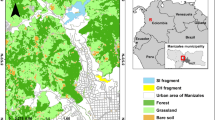Abstract
Understanding the basic natural history of threatened primate taxa is crucial to developing and implementing successful conservation strategies for them. Data on feeding ecology and activity patterns are particularly important for identifying the strategies through which primates invest time and foraging effort towards survival and reproduction at a given locale. Here, we report the results of the first study of the diet and activity budget of Arsi geladas, a population of < 1000 individuals endemic to a heavily disturbed region of the southern Ethiopian Highlands and believed to represent a new taxon of geladas. We conducted our research on a band of 34 individuals belonging to five, one-male units at Indetu, eastern Arsi, Ethiopia, from August 2010 to May 2011 (excluding March 2011). Feeding accounted for 41.7% of total scans, followed by moving (20.3%), resting (19.0%), and social behavior (19.0%). Feeding and moving increased and resting and socializing decreased during the dry season when food availability was probably lower than during the wet season. Geladas ate mostly graminoid leaves (51.7% of feeding scans) though they also consumed graminoid rhizomes (24.4%), forb tubers (7.1%), forb leaves (7.1%), cactus, shrub, and tree fruits (3.6%), graminoid corms (1.7%), forb roots (1.6%), and unidentified items (3.0%). Underground foods (corms, rhizomes, roots, and tubers) accounted for 22–47% (mean = 35%) of the monthly (n = 9) diet and were eaten slightly more during the wet season than during the dry season. Contributions of human crops to the gelada diet could not be quantified without creating conflict between farmers and researchers, though we did note that geladas visited farms on 5–10% of study days. Threats from farmers, children, and dogs limited the geladas’ access to crops once they entered the farms. Further research involving questionnaire surveys of farmers, direct observation of crop damage by geladas, and DNA metabarcoding of gelada feces are crucial to the development of strategies to mitigate human-gelada conflict in the densely populated Arsi Zone of Ethiopia.


Similar content being viewed by others
References
Abu, K (2011) Population census and ecology of a rare gelada population (Theropithecus gelada unnamed subsp) in Indato, eastern Arsi, Ethiopia. MSc thesis, Addis Ababa University
Altmann J (1974) Observational study of behavior: sampling methods. Behaviour 49:227–267
Beehner JC, Bergman TJ (2008) Infant mortality following male takeovers in wild geladas. Am J Primatol 70:1152–1159
Belay G, Mori A (2006) Intraspecific phylogeographic mitochondrial DNA (D-loop) variation of Gelada baboon, Theropithecus gelada, in Ethiopia. Biochem Syst Ecol 34:554–561
Belay G, Shotake T (1998) Blood protein variation of a new population of gelada baboon (Theropithecus gelada) in the southern Rift Valley, Arsi Region, Ethiopia. Primates 39:183–198
Bergman TJ, Beehner JC (2013) Theropithecus gelada. In: Butynski TM, Kingdon J, Kalina J (eds) Mammals of Africa, vol II. Primates. Bloomsbury, London, pp 240–244
Chapman CA, Lawes MJ, Eeley HAC (2006) What hope for African primate diversity? Afr J Ecol 44:116–133
Crook JH, Aldrich-Blake P (1968) Ecological and behavioural contrasts between sympatric ground dwelling primates in Ethiopia. Folia Primatol 8:192–227
Dunbar RIM (1977) Feeding ecology of gelada baboons: a preliminary report. In: Clutton-Brock TH (ed) Primate ecology: studies of feeding and ranging behavior in lemurs, monkeys and apes. Academic Press, London, pp 251–273
Dunbar RIM (1992) Time: a hidden constraint on the behavioural ecology of baboons. Behav Ecol Sociobiol 31:35–49
Dunbar RIM, Dunbar P (1974) Ecological relations and niche separation between sympatric terrestrial primates in Ethiopia. Folia Primatol 21:36–60
Dunbar RIM, Dunbar P (1975) Social dynamics of gelada baboons. Karger, Basel
Fan PF, Fei HL, Scott MB, Zhang W, Ma CY (2011) Habitat and food choice of the critically endangered cao vit gibbon (Nomascus nasutus) in China: implications for conservation. Biol Conserv 144:2247–2254
Fashing PJ, Nguyen (2016) Theropithecus gelada. In: Rowe N, Myers M (eds) All the world’s primates. Pogonias Press, Charlestown, pp 447–449
Fashing PJ, Nguyen N, Fashing NJ (2010) Behavior of geladas and other endemic wildlife during a desert locust outbreak at Guassa, Ethiopia: ecological and conservation implications. Primates 51:193–197
Fashing PJ, Nguyen N, Kerby JT, Venkataraman VV (2014) Gelada feeding ecology in an intact ecosystem at Guassa, Ethiopia: variability over time and implications for hominin and theropith dietary evolution. Am J Phys Anthropol 155:1–16
Grow NB, Gursky-Doyen S, Krzton A (2014) High altitude primates. Springer, New York
Harrison M, Baker J, Twinamatsiko M, Milner-Gulland EJ (2015) Profiling unauthorized natural resource users for better targeting of conservation interventions. Conserv Biol 29:1636–1646
Hunter CP (2001) Ecological determinants of gelada ranging patterns (Theropithecus gelada). Dissertation, University of Liverpool
Irwin M (2016) Habitat change: loss, fragmentation, and degradation. In: Wich SA, Marshall AJ (eds) An introduction to primate conservation. Oxford University Press, Oxford, pp 111–128
IUCN (2017) IUCN Red list of threatened species. Version 2017-1. <www.iucnredlist.org>. Downloaded on 30 June 2017
Iwamoto T (1979) Feeding ecology. In: Kawai M (ed) Ecological and sociological studies of gelada baboons. vol 16. Karger, Basel, pp 279–330
Iwamoto T (1993) The ecology of Theropithecus gelada. In: Jablonski NG (ed) The rise and fall of a primate genus. Cambridge University Press, Cambridge, pp 441–552
Iwamoto T, Dunbar RIM (1983) Thermoregulation, habitat quality and the behavioural ecology in gelada baboons. J Anim Ecol 53:357–366
Iwamoto T, Mori A, Kawai M, Bekele A (1996) Anti-predator behavior of gelada baboons. Primates 37:389–397
Kartzinel TR, Chen PA, Coverdale TC, Erickson DL, Kress WJ, Kuzmina ML, Rubenstein DI, Wang W, Pringle RM (2015) DNA metabarcoding illuminates dietary niche partitioning between African large herbivores. Proc Nat Acad Sci USA 112:8019–8024
Kleiber M (1961) The fire of life: an introduction to animal energetics. Wiley, New York
Lambert JA (2011) Primate nutritional ecology: Feeding biology and diet at ecological and evolutionary scales. In: Campbell CJ, Fuentes A, MacKinnon KC, Bearder SK, Stumpf (eds) Primates in perspective, 2nd edn. Oxford University Press, Oxford, pp 512–522
Mekonnen A, Bekele A, Fashing PJ, Hemson G, Atickem A (2010) Diet, activity patterns, and ranging ecology of the Bale monkey (Chlorocebus djamdjamensis) in Odobullu Forest, Ethiopia. Int J Primatol 31:339–362
Mekonnen A, Bekele A, Fashing PJ, Lernould J, Atickem A, Stenseth NC (2012) Newly discovered Bale monkey populations in forest fragments in southern Ethiopia: evidence of crop raiding, hybridization with grivets, and other conservation threats. Am J Primatol 74:423–432
Mori A, Belay G (1990) The distribution of baboon species and a new population of Gelada baboons along the Wabi-Shebeli river, Ethiopia. Primates 31:495–508
Mori A, Iwamoto T, Bekele A (1997) A case of infanticide in a recently found population in Arsi, Ethiopia. Primates 38:79–88
Mori A, Iwamoto T, Mori U, Bekele A (1999) Sociological and demographic characteristics of a recently found Arsi gelada population in Ethiopia. Primates 40:365–381
Mori A, Belay G, Iwamoto T (2003) Changes in unit structures and infanticide observed in Arsi geladas. Primates 44:217–223
Nguyen N, Fashing PJ, Boyd DA, Barry TS, Burke RJ, Goodale CB, Jones SCZ, Kerby JT, Kellogg BS, Lee LM, Miller CM, Nurmi NO, Ramsay MS, Reynolds JD, Stewart KM, Turner TJ, Venkataraman VV, Knauf Y, Roos C, Knauf S (2015) Fitness impacts of tapeworm parasitism on wild gelada monkeys at Guassa, Ethiopia. Am J Primatol 77:579–594
Oates JF, McFarland KL, Groves JL, Bergl RA, Linder JM, Disotell TR (2002) The Cross River gorilla: natural history of a neglected and critically endangered subspecies. In: Taylor AB, Goldsmith ML (eds) Gorilla biology: a multidisciplinary perspective. Cambridge University Press, Cambridge, pp 472–497
Rowe N, Myers M (2016) All the world’s primates. Pogonias Press, Charlestown
Schwitzer C, Mittermeier RA, Rylands AB, Chiozza F, Williamson EA, Wallis J, Cotton A (2015) Primates in peril: the world’s 25 most endangered primates 2014–2016. IUCN SSC Primate Specialist Group, International Primatological Society, Conservation International, Bristol Zoological Society, Arlington
Shotake T, Saijuntha W, Agatsuma T, Kawamoto Y (2016) Genetic diversity within and among gelada (Theropithecus gelada) populations based on mitochondrial DNA analysis. Anthropol Sci 124:157–167
Struhsaker TT (2010) The red colobus monkeys: variation in demography, behavior, and ecology of endangered species. Oxford University Press, Oxford
Swedell L (2011) African papionins: diversity of social organization and ecological flexibility. In: Campbell CJ, Fuentes A, MacKinnon KC, Bearder SK, Stumpf RM (eds) Primates in perspective, 2nd edn. Oxford University Press, New York, pp 241–277
Tesfaye D, Fashing PJ, Bekele A, Mekonnen A, Atickem A (2013) Ecological flexibility in Boutourlini’s blue monkeys (Cercopithecus mitis boutourlinii) in Jibat forest, Ethiopia: a comparison of habitat use, ranging behavior, and diet in intact and fragmented forest. Int J Primatol 34:615–640
Wallace GE, Hill CM (2012) Crop damage by primates: quantifying the key parameters of crop-raiding events. PLoS One 7:e46636
Williams S, Pol JLV, Spawls S, Shimelis A, Kelbessa E (2005) Ethiopian Highlands. In: Mittermeier RA, Gil PR, Hoffman M, Pilgrim J, Brooks T, Goettsch Mittermeier C, Lamoreux J, da Fonseca GAB (eds) Hotspots revisited: Earth’s biologically richest and most endangered terrestrial ecoregions. Conservation International, Washington, pp 262–273
Yalden DW, Largen MJ (1992) The endemic mammals of Ethiopia. Mammal Rev 22:115–150
Yihune M, Bekele A, Tefera Z (2009) Human–gelada baboon conflict in and around the Simien Mountains National Park, Ethiopia. Afr J Ecol 47:276–282
Acknowledgements
We thank Noel Rowe and Primate Conservation Incorporated, the Primate Action Fund of Conservation International, Columbus Zoo and Aquarium, and the Mohamed bin Zayed Species Conservation Fund for their financial support. In addition, we are grateful to Idea Wild for donating equipment and to the World Association of Zoos and Aquariums (WAZA) for branding this project. Peter Fashing thanks the U.S.-Norway Fulbright Foundation for their support during the preparation of this manuscript. We also thank the Department of Zoological Sciences of Addis Ababa University for logistical support. We are grateful to the Ethiopian Wildlife Conservation Authority, Oromia Regional Forest and Wildlife Enterprise, and District Agriculture Office for permission to conduct this research. We also thank Assefa Hailu of the Natural Herbarium at Addis Ababa University for identification of plant specimens. It would have been impossible to complete the fieldwork without the help of the following field assistants, guides, and camp attendants: Safi Ahimed, Abduraf Muhamed, Abda Mama, Shamil Abda, Sada Safi, Ayub Ahimed, Sano Kabirhusen and Shekadir Gado. Lastly, we thank John F. Oates and an anonymous reviewer for their helpful comments on this manuscript and Colin P. Groves for sharing his insights into the complexities of gelada taxonomy.
Author information
Authors and Affiliations
Corresponding author
About this article
Cite this article
Abu, K., Mekonnen, A., Bekele, A. et al. Diet and activity patterns of Arsi geladas in low-elevation disturbed habitat south of the Rift Valley at Indetu, Ethiopia. Primates 59, 153–161 (2018). https://doi.org/10.1007/s10329-017-0640-9
Received:
Accepted:
Published:
Issue Date:
DOI: https://doi.org/10.1007/s10329-017-0640-9




